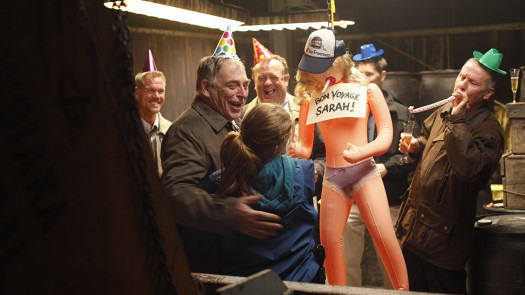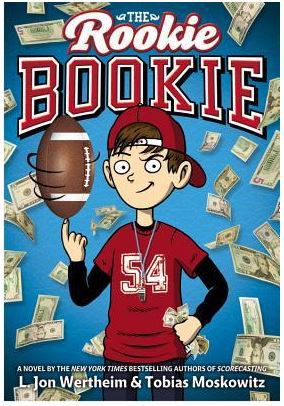So that was intense, huh? The pilot of The Killing, expertly directed by Patty Jenkins, opens with our main character, Sarah Linden (Mireille Enos), taking a morning jog through the woods. This scene is intercut with a flashback of a terrified teenage girl, screaming while she’s chased at night through what is presumably those exact same woods. Thanks to a close-up shot lit by a flashlight, we find out the young girl is Rosie Larsen (Katie Findlay), as seen in the marketing poster. The pounding, percussion-heavy score by original Forbrydelsen composer, Frans Bak, only adds to the intensity of the scene, as Rosie’s attacker catches up with her before we cut to Linden finding a body by the lake. The body is revealed to be that of an animal, resulting in the first of many (and there are many) fake-outs that will be deployed during the pilot. It’s a menacing start to the show, packed full of tension and dread.
The next scene opens with an on-screen title stating: DAY ONE. As with Twin Peaks and Forbrydelsen, the timeframe of The Killing covers an approx 24 hours per episode. Linden is called to a crime scene involving a “Jane Doe.” She navigates through the building by torchlight, walking past bloodied walls and debris, leading up to a body bag, which is unveiled as a fake. Her colleagues have thrown her a surprise party, as it’s her last day as a homicide detective in Seattle, Washington. Yes, we’re only five minutes into The Killing and we’ve already had two fake-outs, but it’s all about building suspense. We know we’ll eventually be on the path of a murder investigation, so why not mess with the audience for a while? Furthermore, it shows how writer/showrunner, Veena Sud, has injected a sense of humour into what is otherwise a very cold, depressing story.

We’re then introduced to Linden’s fiancée, Rick Felder (Callum Keith Rennie), at their apartment. He’s finishing up packing before their move when she enters the room carrying the blow-up doll from her party, and they have a playful interaction with each other. Mireille Enos plays Sarah Linden with a greater sense of cuteness and levity than her Danish counterpart, Sarah Lund (Sofie Gråbøl). In Forbrydelsen, Lund is a much more withdrawn and emotionally distant character, but both actresses excel in their respective roles. They may wear the same kind of knitted sweater, but internally they’re two very different characters.
At the police station, Linden meets her replacement, Stephen Holder (Joel Kinnaman). He appears to be a somewhat dishevelled, clumsy character accentuated by Kinnaman’s lanky frame. Kinnaman skilfully portrays Holder like a streetwise smartass, which is again very different from his Danish equivalent, Jan Meyer (Søren Malling). Meyer is the classic TV cop type, played earnestly by Malling. It’s a credit to Veena Sud that she didn’t remake Forbrydelsen beat-for-beat. By keeping the core story of Forbrydelsen intact, but changing various aspect to suit her vision, Sud allows The Killing to stand on its own, whilst being respectful to the brilliant Danish original. At the end of the scene, Lieutenant Michael Oakes (Garry Chalk) informs Linden and Holder they’ve had a call from Discovery Park, so he wants them to check it out, despite it being Linden’s last day before she moves to San Francisco, California.
What follows is a scene that will become a regular occurrence over the course of The Killing, as Linden and Holder drive to the crime scene while rain is pouring down. The driving scenes are often used to develop the relationship between our two leads, the first of which is used to tell us about Holder’s previous undercover work, which could explain his informal dress sense and unusual demeanour. Rain is a continuous element used to emphasise the mood of the show, as its ever-present presence heightens the darkness and bleakness of the story. At times, the rain almost feels like a character, in its own right. It’s also important to mention how Seattle is a perfect setting for the story (even if it was filmed in Vancouver). A series of establishing/wide shots photograph the grunge capital of the world with a sense of claustrophobia, as its imposing monochrome buildings loom over the city, further heightening the tension and suspense.
A bloodied pink sweater and Stanley Larsen’s ATM card are found at the crime scene, which could provide us with our first suspect, although a body has not yet been found. We know Rosie Larsen is the murder victim because of the marketing poster, so could we be looking at a family-related crime? I guess we’ll find out over the coming weeks. Linden suggests the case should be handed over to Sex Crimes, whereas Holder wants to talk to Stanley Larsen. As Holder walks away, a close-up is used to focus on a cross tattoo on the back of his neck, which indicates some sort of religious connection with the character.
Up next are the introductions of Stan Larsen (Brent Sexton) and Belko Royce (Brendan Sexton III), who work together under the name “S. A. Larsen,” a moving and storage company. Belko appears to be a confrontational character when he refers to an Asian man as “Osama.” His outright racism and cavalier attitude immediately lets us know he’s someone to watch. Stan receives a call from his wife, Mitch Larsen (Michelle Forbes), and they’re shown to be an affectionate, playful couple. Mitch tells Stan their daughter Rosie is thinking about moving away for college, which distresses him, as he feels she’s too young. This shows Stan to be a loving, caring father, although at this stage it doesn’t really matter much because we all know how Twin Peaks panned out.
We cut to Seattle City Council president and mayoral candidate, Councilman Darren Richmond (Billy Campbell), standing in a graveyard. He receives a call from his campaign manager, Jamie Wright (Eric Ladin), and leaves the site. Richmond is met at City Hall by Jamie and his campaign advisor, Gwen Eaton (Kristin Lehman), where it’s revealed that Richmond and Gwen are sleeping together. During a staff meeting, Richmond reveals that Councilwoman Ruth Yitanes (Lee Garlington) will be endorsing him, which could be a deciding factor in him beating Mayor Lesley Adams in the election. Not much is learned character-wise from this scene, but going forward, the importance of the election will be a major part of The Killing.
Linden and Holder arrive at the Larsen family home, looking for Stan. Linden deduces that the Larsen’s have a daughter after she spots a pink bike in the garage. They meet Mitch, and she reveals they were on a camping trip over the weekend, although Rosie stayed at home and they haven’t spoken since Friday. It does seem careless to not call your teenage daughter when you’re away all weekend, doesn’t it? We’re then briefly introduced to Rosie’s best friend, Sterling Fitch (Kacey Rohl), in the high school halls. She seems worried about Rosie being missing, and her nose starts to bleed. This could be a play on the “Twin Telepathy” trope, in which twins are often shown as having a psychic link. Sterling’s nose bleed could suggest she has a feeling about Rosie being in danger, despite her apparent unawareness regarding Rosie’s whereabouts. Her teacher, Bennet Ahmed (Brandon Jay McLaren), thinks she’s lying.
We cut back to Linden and Holder questioning Mitch about Rosie. We learn Rosie went to a Halloween dance at school on Friday, leaving the house wearing a pink sweater. Mitch claims her phone was out of range all weekend, and that she wasn’t worried about Rosie because she’s not some little kid. Linden looks at pictures around the house, focussing on one of Rosie, which is very reminiscent of the iconic Laura Palmer picture from Twin Peaks. The school phones Mitch to tell her nobody has seen Rosie since Friday’s dance, not even her best friend, Sterling, with whom she was supposed to be staying while her family were away.
Backstage at a student assembly, Richmond asks Gwen to move in with him, and she seems reluctant. He’s informed that the police want to see him because the school is a potential abduction site. He and Mayor Adams (Tom Butler) agree to postpone the assembly, in service of the investigation. Linden and Holder question Bennet, who chaperoned the Halloween dance. Bennet states that Rosie was with Sterling at the dance, and was wearing a witches costume. Holder uncomfortably asks Bennet about Rosie’s looks, trying to detect whether or not he’s a suspect. This shows the difference in policing styles between Linden and Holder. She’s a more straightforward, by-the-books type, whilst he shows signs of being unconventional and erratic. Linden is informed that something has happened with her son, Jack, at his school.
Sterling goes to meet a kid called Kris Echols (Gharrett Patrick Paon), as she’s looking for Jasper (Rosie’s on-off boyfriend). Kris tells Sterling that Jasper’s parents are away, so he’s at home, using drugs and there’s a chance Rosie might be there with him. Jasper Ames (Richard Harmon) is a stereotypical spoilt rich kid, who has left his parents’ home in a mess, and a woman can be heard groaning from upstairs. Linden reprimands her son, Jack Linden (Liam James), for smoking at school. Jack doesn’t want to leave Seattle, but she leaves him with Regi Darnell (Annie Corley), a family friend. Back at the Larsen home, Mitch’s sister, Terry Marek (Jamie Anne Allman), enters with Mitch and Stan’s two younger sons. They’re excited about seeing Rosie, as she’d promised them they’d go biking together. Mitch is starting to stress about Rosie whereabouts, and Terry tries to calm her down by saying she’ll turn up.
In the woods, a K-9 has picked up a scent, but there’s still no burial site. Holder reveals that Stan’s alibi checks out, as the Larsen’s car never left the campsite. For now, Stan is not a suspect, so it looks like we don’t have to deal with another Leland Palmer. Linden is told a burial site might have been found in another part of the woods. At City Hall, Jamie tries to convince Richmond to use Rosie’s disappearance to their advantage, something he refuses to exploit. This shows Jamie as being a ruthless character, unlike the seemingly upstanding Richmond. Richmond believes a staff member is releasing information after Mayor Adams knew about his endorsement from Councilwoman Yitanes, and now a reporter has found out about some off-the-books trips he had taken. He is told Jamie and Gwen knew about the trips, which now questions the reliability of all three characters. Are any of them to be trusted? After all, they do work in politics, but how far would they go to get what they want?
At this point, it seems right to mention how The Killing differs to Forbrydelsen in terms of the political plot. Even though The Killing features politics quite heavily, I’d argue Forbrydelsen leans even heavier on that part of the story. Darren Richmond’s Danish predecessor, Troels Hartmann (Lars Mikkelsen), is positioned as the third lead in Forbrydelsen, though that’s not to say Richmond isn’t an important character in The Killing (because he obviously is). Although the politics have definitely been pushed back in favour of the murder mystery in The Killing, the Richmond campaign plot is still key to the story, even if it doesn’t have an equal importance like the political plot in Forbrydelsen.
Next, we see Stan confront Sterling, who suggests Rosie is with Jasper. Stan wrongfully calls Mitch to tell her Rosie’s whereabouts, and the message is then forwarded to the police. The police believe they have found something in the woods, but it’s yet another fake-out (it’s just a rather creepy doll). Stan arrives at Jasper’s house and lifts the sheets off the women lying in bed, quickly realising it’s not Rosie. After spotting a group with fishing rods, Linden wonders what’s on the other side of the woods, and Holder tells her there’s a lake. Later, we see a car being lifted from under the lake, while Linden and Holder nervously look on. Stan calls Mitch to say Rosie wasn’t with Jasper, so he’s driving to Discovery Park because that’s where they found Rosie’s sweater.
Stan arrives at the lake with Mitch still on the phone, just as Linden and Holder open the trunk to reveal Rosie’s body. It’s a haunting scene, which eerily evokes the moment Leland and Sarah find out about Laura in Twin Peaks. Stan breaks down in front of the cops, while Mitch screams Stan’s name over the phone, as her two young boys look on. Like earlier, the rain is pounding away, which adds to the gloom, underlined by Frans Bak’s beautifully arranged melancholic score. Brent Sexton and Michelle Forbes are both brilliant during this scene, capturing the pain no parent should have to go through in real life. We’re told the car belongs to the Richmond campaign, which gives us our first set of suspects. Could this be yet another red herring? Maybe, but only time will tell. A brief montage ends with a close-up on Rosie’s lifeless corpse, concentrating on a butterfly necklace around her neck. Again, it’s yet another reminder of Twin Peaks and Laura’s necklace. Rosie may not have been wrapped in plastic, but she was still submerged underwater, resulting in that truly horrifying greyish zombie-like tone.

So, that’s it. The end of the first episode. As you can tell, The Killing is structured with three main plots: the first of which revolves around Rosie’s murder and the subsequent investigation, the second is about the Larsen family and their lives in the wake of Rosie’s death, and the third is about the Richmond political campaign and its entanglement within the case.
In many respects, this article about the pilot is more for the first time watchers than the long-term devotees. I wanted to recap as much of episode one as possible, going into detail scene-by-scene. However, from here on out, The Autopsy of The Killing will be presented slightly different, as we’ve been introduced to the setup of the show and can move into a less expository presentation. I’ll be splitting each new article into three sections: the first of which will be called “New Evidence,” which will highlight any new information about the murder case presented during the episode; the second will be called “The Suspects,” which will focus on the key suspect(s) during the murder mystery; and the third will be called “What Year Is This?” and will spotlight any similarities between The Killing and Twin Peaks during said episode.
Although The Killing revolves around three different plots, my main focus going forward will mostly be about the murder investigation. “Who Killed Rosie Larsen?” is the gateway into the world of The Killing, so I want to look at the show from Linden and Holder’s perspectives and highlight the arcs of any potential suspects. Obviously, the Larsen family and Richmond campaign will still feature in future articles, but the murder mystery will take priority over the two other plots. It will be a different experience for me, as a long-time fan, to strongly focus on the investigation, trying to piece together every bit of evidence, whilst avoiding any inessential narrative that doesn’t directly connect to Rosie Larsen.
Oh, and just in case you wondered, Linden is definitely here to stay. Sorry, but there will be no California sunshine for you, Linden!
The next article, The Autopsy of The Killing: Part 2 – The Cage, will focus on the second episode of The Killing, written by Veena Sud and directed by Ed Bianchi, respectively.
If you’re enjoying this series, I want to hear from you! Leave a comment below, and/or give me a follow on Twitter (@JonSheasby), and we’ll continue the conversation over there.
And as always, please avoid posting spoilers, because I want this series to be enjoyed by fans both old and new. Once an episode has been discussed, then you can talk about it as freely as you like, but until that time… keep the mystery alive.
Help us keep the conversation alive! We publish new content daily that can easily be found by following us on Twitter @25YLSite, joining our Facebook group or becoming an email subscriber here on the site. Thank you as always for your support of 25YL!
Share this:




